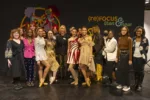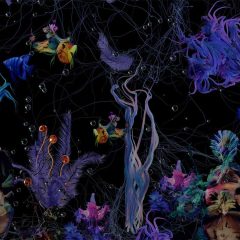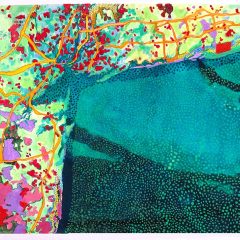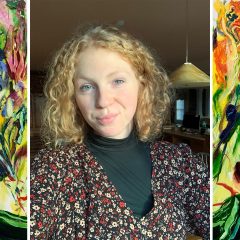
Laylah Ali, untitled, 2005, gouache on paper paintings, all images here provided by Ali
Layla Ali gave a talk a couple of weeks ago, part of the University of the Arts Food for Thought lecture series organized by the Summer MFA program. I’ve been thinking it over for this long because she’s a bit elusive.
Ali placed her work in the context of self-portraiture, part of her undergraduate practice at Williams College (BFA 1991). Of her early self portraits, she said she was trying to do them with Nat Turner’s vision, and that family memories of slavery are part of the baggage she brings to the table.
But even if you saw what Ali looks like–a slender, bespectacled, person who manages to mix diffidence with no nonsense–you still wouldn’t know who she is. And that’s her point about portraiture and self-portraiture. Self-portraits are filled with “lies and mistruths.” She added, “People’s expectation of a self-portrait is overwhelming to me.”
Tellingly enough, no one was allowed to take photographs at Ali’s talk. So I don’t have a shot of her. (But she kindly sent along the images afterwards that I am posting with these words.) The good news is, if you want to see what she looks like and get a better sense of her, you can go to Art:21.
Ali said she hit a turning point when she declared, No more self-portraits, a critical move made at Skowhegan. (Some other educational bona fides–she also has an MFA from Washington University, St. Louis, and was in the Whitney’s Independent Study Program after graduating Williams).

Laylah Ali, untitled, Greenheads Series, 2000
It’s not that Ali has really changed her subject matter. “I am interested in myself, my own body, my history,” she said. Those interests carry over into all her work, including the work for which she is best known, the Greenheads Series, in which teams of figures–caligraphic, flat, layed out like semaphores on her drawing paper–are all to be interpreted as her, to some degree. “I hated dodgeball; I still do,” she said as a way to explain where the series came from.
She offered a long list of what her work was about. Here are a few that I jotted down.
figures as an ever-changing alphabet
the body as a (bad) joke
rage meted out, controlled
scars
checking each other out
flatness as a barrier, a demarcation between worlds
utopia/dystopia
The list was longer.
I am sorry she didn’t send along one of the pre-Greenheads Series works, circular heads in a grid with tongues sticking out. The one she showed at the talk were different shades of brown in colored pencil, but she did them in other colors as well, like pink and green. She also did a 6 x 6-foot grid of portraits of the presidents which included quite the range of hair adornment.

Laylah Ali, untitled, 2005, gouache on paper paintings
The grid of round heads immediately reminded me of Ellen Gallagher and her grid of brown-skinned heads with gloppy hair; the presidents and their hair styles cemented that connection for me. But she’s not on Ali’s short list of influences. She mentioned comic books, Ida Applebroog, for how she broke up the canvas; Cindy Sherman, for her self-portraits with wigs; Sophie Calle (I missed what she selected as how Calle’s work influenced her, but the self-portraiture as autobiography and the idea of proving her own existence seem pretty relevant to me); and David Hammonds for his playfulness in handling big subject matter (she mentioned his piece that involved selling snowballs on the street).
In 1996, Ali added anemic bodies in superhero costumes to the round heads and thus the Greenheads Series began. She said they were “me and not me, ” and she’s interested in “that middle place” between individuals and types. She thinks of the clothes on her figures as costumes. (She mentioned this later in answer to my question about fashion.)

Laylah Ali, untitled, Greenheads Series, 2000
Over time, the Greenheads have become more covered up so less brown skin is showing, because people’s identification of the figures “had so much to do with racial identity.” It’s not that people were wrong so much as they couldn’t see beyond it to the larger truths in the work.
But of course, because Ali’s work is so much about how people identify others by looking at them, race is still the elephant in the room, at least in this culture. The thing about Ali’s work, though, is that she is all about how we look and how our appearance never gives a full portrait; nonetheless, it does serve as a form of communication between humans, with signals that lie.
Overwhelmingly, Ali implies stories behind what she puts on the paper. The stories are there to be puzzled over and searched out and imagined, but they are never spelled out. She’ll add a scar or a band-aid. You get to think about what the violence or injury might have been. And the relationships between the figures communicates tension and wariness, not just in the Greenheads Series, but in the drawings that she showed at the Morris Gallery earlier this year (see posts here and here). Her figures–their costumes, their injuries, their public face–expose identity at the same time that they hide identity.
Those later drawings, from the Typology Series, are looser than the gouaches. The tension of the figures projecting their identities is still there, but the tension of the actual way they were made was not. Ali spoke about how, using gouache, she was controlling color and the edges, to “move away from what my hand wanted to do.” The need to add a “filter or control something” was part of not just her message and thinking but part of her process. “Just because it feels good, doesn’t mean it’s worth anything.” Other people may not want to look at what you’re doing, even if you’re enjoying doing it. She later said, “I love to draw. Drawing to me is where it’s at.”
Keeping in mind she was talking to students, she talked a lot about her process. Regarding her book project for MoMA–a comic book, which she creating working with a computer technician using Adobe Illustrator, who based the images on Ali’s pencil drawings, Ali said the computer made it easier to make multiple figures. However, it was harder to make them quirky and varied on the computer. She said she worked on 20 paintings at once. And she did left-handed drawings for a while because she had tendonitis. To keep the precision, she used an eraser and a razor blade. She works at the kitchen table and listens to NPR, the BBC, and cuts things out of the New York Times. She said the smartest thing she had done was to always have a studio space. She also said she made the right decision in avoiding taking an administrative job.

Laylah Ali, untitled, 2005, gouache on paper paintings
A lot of what I do is searching and doubting,” she said. “Doubt and questioning is an important part of the practice.”
Taking on the go-go art market, she questioned the race to spectacle and scale that bowls over and shrinks the viewer. “I did do a billboard project for the Walker, but you’re driving by so fast it doesn’t matter,” she added with typical diffidence. She cited Australia (she met her husband there and he’s an Aussie) for more government support for younger artists, giving them the freedom to be more experimental in their careers. “Here you can switch to film if you’re a megastar,” she added.
At the end, she summed up about her work: “It’s kind of like meeting people. You guess what the story is just from the way he looks. It’s an impossible endeavor to read someone else just from what they present to you.”









